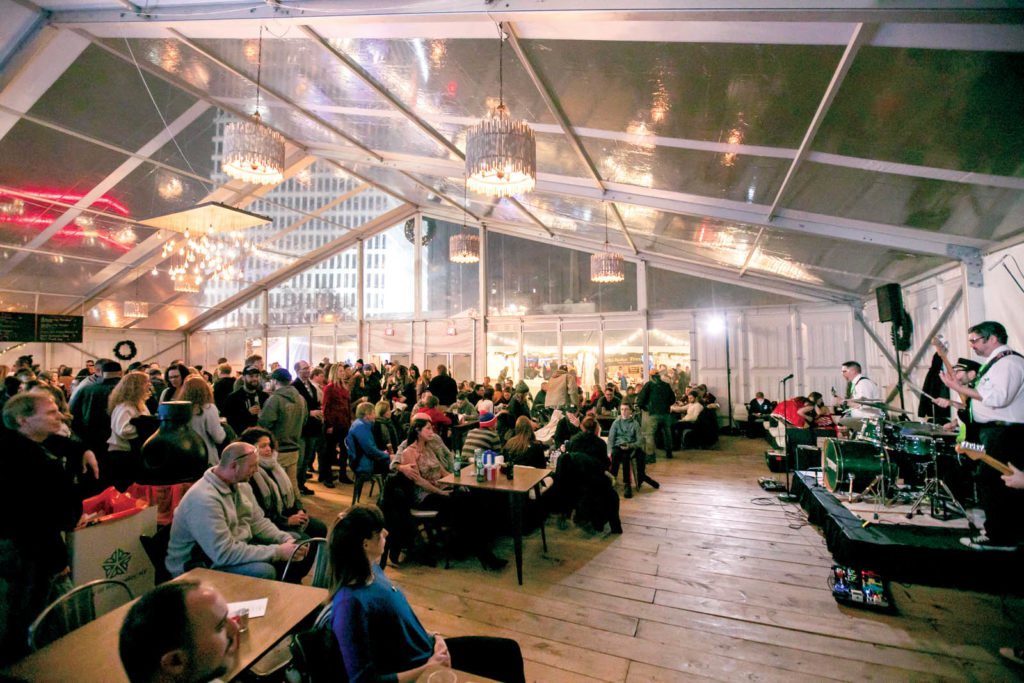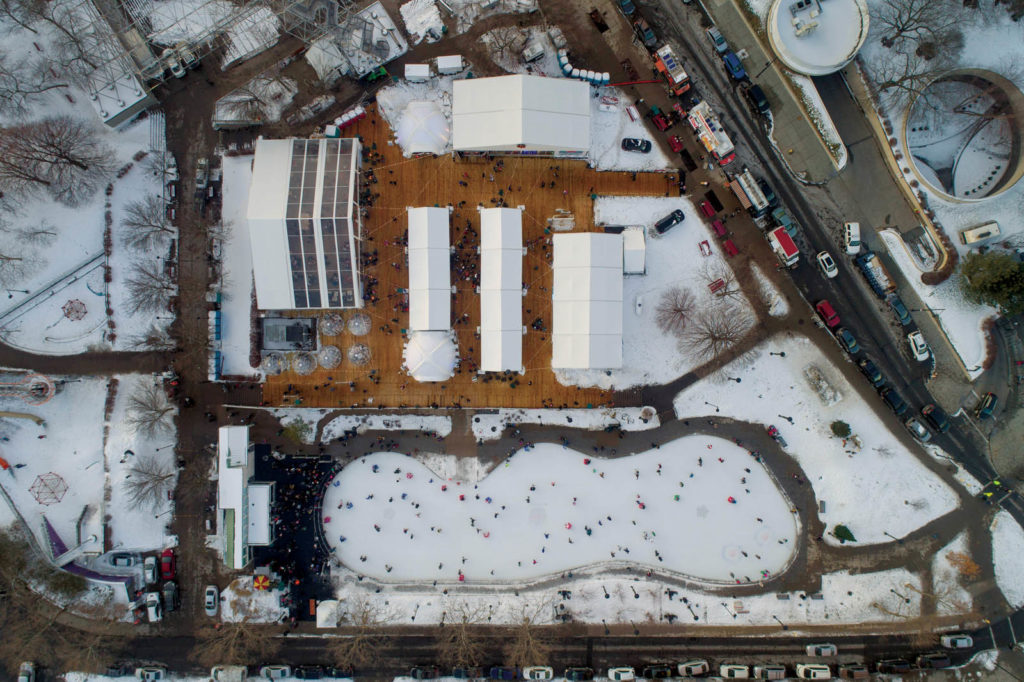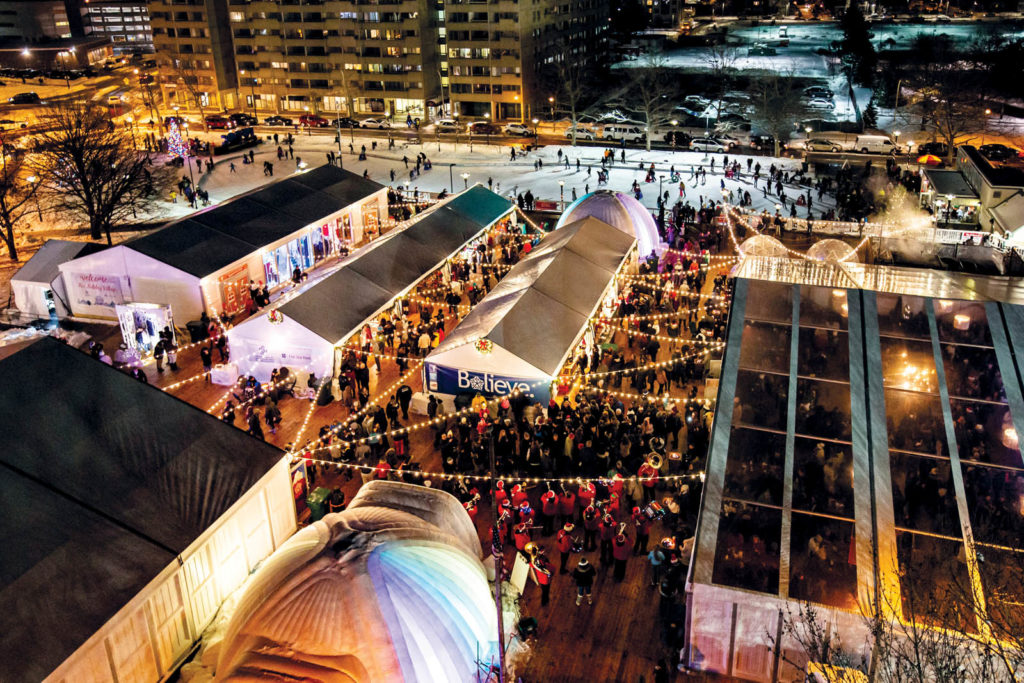McCarthy Tents and Events puts community first with a holiday event—despite the risks of the day.

by Sigrid Tornquist
To plan an event today means taking more risk than ever. Given COVID-19 and its known and unknown variants, the stakes are particularly high. Before plans are set in motion and before a single stake is driven into the ground, certain questions are asked by everyone involved: Will people show up to the event? Will we be able to keep those people safe? How does one measure the importance of providing a place for community to gather against the risk of something going wrong? Will this be an event that shores us up financially or will it be something we need to recover from?
These are questions currently faced by tent and event planners with every event they consider undertaking. For Sean McCarthy, president of McCarthy Tents and Events in Rochester, N.Y., he’s willing to take the risk to again provide the community he loves with a holiday village—Roc Holiday Village—a celebration of the holidays, winter, economic vitality and community.

Reigniting midtown
One thing that makes this festival unique for McCarthy is that it is owned by his company. McCarthy first envisioned the annual event in 2018 as a way to bring back a tradition that started in the mid-20th century. “The mall in midtown Rochester was the place to go see Santa up until the 1990s,” McCarthy says. “Around that time everything moved out to the suburbs, and in the spring of 2018 we started thinking about how we could bring that energy back to town.”
One perk of owning both the festival and the tent and event rental company was that “even that first year doing it, we could pretty much go all out,” McCarthy says. “We were able to do it the way we wanted to as opposed to doing a small version and trying to grow it. We made it exactly what we wanted it to be from the start—installing full structures, glass walls, hard walls, doors—everything.”
McCarthy Tents and Events ran the event in 2018 and in 2019, but in 2020 the event was paused due to COVID-19. The event is scheduled to reopen in December 2021 with its signature ice skating, Santa’s Workshop, live music, bar, crafts and a petting zoo. As McCarthy envisions how to structure the event in times of COVID, he and other organizers are following recommended guidelines. “Much of the event naturally happens outdoors so that part isn’t too concerning,” McCarthy says. “But the fact is we make much of our money on the bar, which is in one of the large tent structures that is divided into two spaces. Beyond that, there is more of a focus on outdoor heaters, outdoor firepits, etc.”

An unconventional flooring solution
The most daunting challenge for the installation results from the combination of the site and the time of year. “It’s a tough site because it’s a big open grass field, which doesn’t work for a winter festival at all,” McCarthy says. “So, we looked at different ideas for it and eventually settled for probably the hardest way.”
McCarthy decided to use treated plywood, which he points out is an unconventional solution. For a typical plywood floor, he explains, you use stringers every 2 feet below the plywood. “In this case, we wanted to do wood on top to be aesthetically nice looking but also so it would be drivable for plowing with a Tent OX™,” he says. “So just doing plywood wouldn’t cut it. The plywood would be too slippery, and there would be nowhere for the water to go.”
The crew installed approximately 30,000 square feet of pressure-treated wood, using approximately 50,000 screws. The stringers underneath were each 2 inches by 10 inches and 12 feet long. On top of that the crew laid 12-foot-long 2-by-8-inch boards, each one abutted against the next. “We did this over and over a thousand times,” McCarthy says. “The undertaking is pretty epic. It was unconventional but for a winter installation, it makes sense.”
Installation includes three structures, all in the 3,000-to-4,000-square-foot range; along with smaller tents to accommodate the 28 vendors. Some vendors offer food for festival goers, but the majority are selling high-end custom items such as jewelry, clothing, etc.
The festival begins the first weekend of December and runs through Christmas, and installation began at the end of October. “We won’t run through New Year’s this year, though we did in 2019,” McCarthy says.
It’s an accomplishment that McCarthy is rightfully proud of. It benefits the community in several ways—the city owns the land and so is glad to see it be used in this way, festival-goers enjoy gathering and celebrating the season and businesses prosper as well. “Still, it’s a risk right now because who knows what’s going to happen [in terms of COVID-19],” he says. “We went back and forth about whether or not to move forward with it this year but all the sponsors were in, and much of it is outdoors so we decided it was worth it.”
Sigrid Tornquist is a Minneapolis, Minn.-based writer and editor, and a former InTents editor.
SIDEBAR: By the numbers
3 main structures = 3,000+ square feet of tenting
30,000 square feet of pressure-treated wood
50,000 screws for flooring
 TEXTILES.ORG
TEXTILES.ORG


